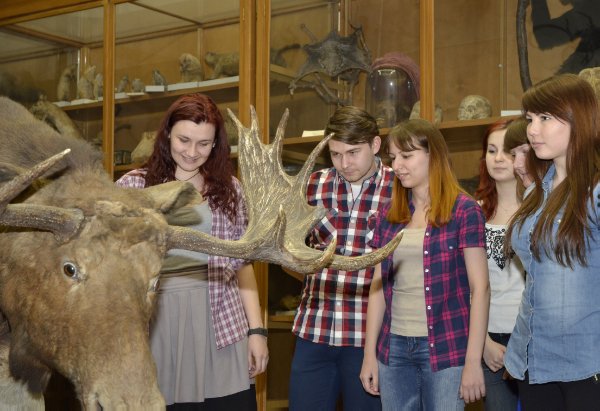
The first hall of the Museum demonstrates collections of invertebrates from Protozoa to mollusks and Crustacea. At the beginning of the exhibition one can see plaster models of remarkable Protozoa tests - Foraminiferida, which live on bottom of seas and oceans. They can be of really gigantic size for single-celled. In some Northern seas of our country one can find Forminiferida of two-three cm size.
Endangered nummulites up to six cm in diameter - Foraminiferida, which shape resembles coins, formed big layers of limestone in Northern Africa millions of years ago. Such limestone beds under the sand of Sahara desert on the place of former sea. Pyramids of Egypt are built of blocks, which consist of pressed nummulites' shells almost completely. The so-called Fusulinacea stone, which was named "bread stone" in Russia, is formed of Foraminiferida. Temples in Vladimir and Suzdal cities are made of it. There are also samples of "bread stone" in the exhibition.
Radiolaria, which are related to Foraminiferida and stay in the sick of water, form delicate skeletons of silicium oxide. The specialist on Radiolaria P.Ye.Vasilkovsky wrote that
"it seems that all these laces are not living creatures but thinnest jewelry made to decorate sea princesses' finery. The variety of their forms is definitely inexhaustible. The outlines of their skeleton covers are so regularly drawn as if these works of art were created by the best masters".
Then we go to the stalls with the collection of sponges, the primitive aqueous multicellular organisms. They have neither sense organs - eyes, nor ability to move and spent all their life fixed on the bottom.
Here one can see a glass sponge of striking beauty known as "Venus's Basket". The story of its relationship with small spongicola is quite interesting. Two spongicola, male and female, live in the cavity of almost every sponge. They get there at the larval stage and can not leave it later. These creatures spend all their life together, caged in the sponge cavity.
In Japan, where the species called "Venus's Basket" inhabit, there is an old tradition to present a sponge with two spongicola for wedding as a symbol of eternal love and conjugal faithfulness. The exhibition also shows a soft skeleton of toilet sponge, which has been used by people for washing since ancient times.